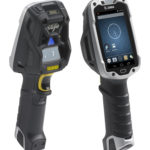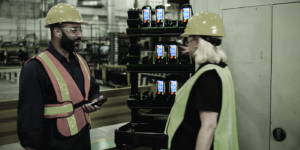Though fully in effect by the year 2020, major sweeping changes are underway within the enterprise mobility industry (see milestones guides).
 Current Microsoft handheld operating systems are going by the wayside in favor of Android – a much more user friendly, familiar choice that will prove to be more flexible over time, considering the cross-functional opportunities of being in the consumer and enterprise market. While early editions of Windows Embedded Handheld systems were the practical choice, mainly because of PC’s domination of both the small business and corporate market, newer versions of WEHH not only went away from its traditional UI/UX, but the move seemed to come with no regret.
Current Microsoft handheld operating systems are going by the wayside in favor of Android – a much more user friendly, familiar choice that will prove to be more flexible over time, considering the cross-functional opportunities of being in the consumer and enterprise market. While early editions of Windows Embedded Handheld systems were the practical choice, mainly because of PC’s domination of both the small business and corporate market, newer versions of WEHH not only went away from its traditional UI/UX, but the move seemed to come with no regret.
Enter WEHH 8.1 up to Windows 10; the OS closely mirrors the look of that of the consumer side – flashy app tiles, minimized interface nav. choices and the general idea that “less is more”, when in reality “more” was needed, especially for enterprise users, where thousands of commands maybe inputted daily. What enterprise end-users found was that patching older versions of their current OS through either MS provided or 3rd party support updates was more favorable for their needs – and required less labor, no additional training and overall a better short term fix vs playing the long game. The same enterprises were comfortable with updating business software, company databases and other operations that were managed through their mobile devices rather than trend upwards by purchasingw new solutions and new hardware that could last the sands of time. This is as to say, a complete mobility solution could make things easier later on, because of the idea that compatibility issues with their older OS and hardware would exist.
However inevitability is now winning – the programs and business apps that operate on these devices would someday (which is now) need to be rewritten or migrated once the sun finally set on WEH6.5, WM 5.0, CE6 and their successors, including 8.0, 8.1 and 10. Microsoft has long preached their interest in supporting the enterprise customer, however they are moving away from handheld development all together and are instead focusing on core competencies, which is going to be problematic for many companies moving forward.
Back to Android…
Anyone that knows handhelds knows that Android is the consumer and enterprise’s version of what PCs are to Apple computers. Apple, in most of what it does is independent, while Android is much more open to 3rd party development. Android’s agnostic nature makes it the perfect choice for enterprise and most workforce mobility manufacturers have taken note. It’s for that same reason that Android has roughly 80% market share on the smartphone side and a growing pool of capable developers, which is something oft seen in hindsight, after choices are made by companies that look to build a new mobile handheld and network infrastructure. This can cause problems later.
 Zebra’s TC series, especially the TC8000, TC51 and TC56 not only carry Android, but have changed the game for workforce handheld devices in general, with more ergodynamic designs and addition of touch screens unseen in previous models of traditional “Scanner guns”. When coupled together, you get the same look and feel as the smartphone you gravitate towards (including outbound calling) but also gain enterprise functions for running mission critical tasks, such as barcode/RFID scanning and PTT. Most importantly, you have the enterprise strength you expect behind you for flawless system integrations of your business applications, databases and connection to the web for anything you need to pull from online. With all of that said, Android is clearly the best positioned to handle the load of enterprise activities, no matter the role, department or level of responsibility an employee has. The dream of making the employee’s mobile device an all-in-one solution that connects work tasks, everyone and everything else together is now a reality.
Zebra’s TC series, especially the TC8000, TC51 and TC56 not only carry Android, but have changed the game for workforce handheld devices in general, with more ergodynamic designs and addition of touch screens unseen in previous models of traditional “Scanner guns”. When coupled together, you get the same look and feel as the smartphone you gravitate towards (including outbound calling) but also gain enterprise functions for running mission critical tasks, such as barcode/RFID scanning and PTT. Most importantly, you have the enterprise strength you expect behind you for flawless system integrations of your business applications, databases and connection to the web for anything you need to pull from online. With all of that said, Android is clearly the best positioned to handle the load of enterprise activities, no matter the role, department or level of responsibility an employee has. The dream of making the employee’s mobile device an all-in-one solution that connects work tasks, everyone and everything else together is now a reality.
So, you have read all of this (if you made it here) and are now wondering what to do, specific to your situation.
Here’s what you’re looking at generally, given no one company, no one work environment is the exact same:
- Obsolete hardware that is not compatible to new OS options will need to be discontinued or reassigned and new handheld devices purchased/integrated.
- Business applications, business system databases, day-to-day operations or general programs currently running within any non-compliant OS’ will need to be rewritten.
- Any of the above programs that are compatible to a new OS will need to be migrated.
- Intense testing of migrated programs will need to be completed (bugs, issues, etc. will arise and need to be ironed out)
- Wired Networks and Wireless LAN will need to be reconfigured to any new devices.
- Your management and support processes for handhelds will need to change.
- Retraining of all employees that utilize your handhelds in any capacity is likely, though to what extent is varied considering each employee’s usages of/purposes for devices.
If there is one thing in all of this to keep in mind, updating your hardware and apps to be Android compatible will prove to make your current workforce more productive… and the innovations of both mobility and software you integrate will hopefully make for positive changes to your workflow processes. After all, quoting Andy Dusfrene from the famous book and movie The Shawshank Redemption “Hope is a good thing, maybe the best of things, and no good thing ever really dies”
As for that “dying” part in the quote, well, I guess it sort of makes sense in the tech world. In the end, tech is only as good as the users that operate it. In this case, Android is an operating system that isn’t going anywhere, which after your OS migration and any device upgrades should be music to your ears.
Here’s some additional reading that may help below, but check out our published guides on the topic here.
Zebra Workforce Mobility Guide #1 – Introduction to OS Migration and Benefits
Zebra Workforce Mobility Guide #2 – Innovations in Mobility and Zebra’s Android Product Line
…and here’s a webinar on our YouTube page, provided by VDC Research:
Migrating Legacy Mobile Applications: Getting it Right Means Everything